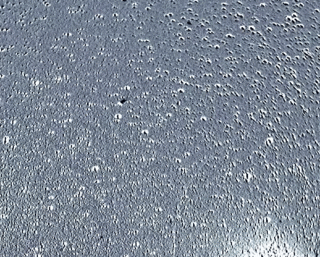Comet Leonard
Comet Leaonard as captured by NASA’s Solar Terrestrial Relations Observatory-A (STEREO) spacecraft, HI-2 telescope, which has watched the comet since early November. This animated “difference image” was created by subtracting the current frame from the previous frame to highlight differences between them. Difference images are useful for seeing subtle changes in Leonard’s ion tail (the trail of ionized gases streaming from the comet’s body, or nucleus), which becomes longer and brighter toward the end of the clip.
 data the ESA/NASA Solar Orbiter spacecraft sent back to Earth as it observes comet Leonard, a mass of space dust, rock and ice just over half a mile across (1 kilometer) as it heads inbound to the sun.
data the ESA/NASA Solar Orbiter spacecraft sent back to Earth as it observes comet Leonard, a mass of space dust, rock and ice just over half a mile across (1 kilometer) as it heads inbound to the sun.Karl Battams, Ph.D Credit: NRL
Imagery captured between Dec. 17 and 19 by the NRL’s Solar Orbiter Heliospheric Imager (SoloHI) aboard the ESA/NASA Solar Orbiter spacecraft, shows comet Leonard streaking diagonally across the field of view. Planets Venus and Mercury are also visible in the top right, Venus appearing brighter and moving from left to right.
“When SoloHI recorded these images, the comet was approximately between the Sun and the spacecraft, with its gas (ion) and dust tails pointing towards the spacecraft,” Karl Battams, Ph.D., a computational scientist in NRL’s Heliospheric Physics section said. “Toward the end of the image sequence, our view of both of the tails improves as the viewing angle at which we see the comet increases, and SoloHI gets a side-on view of the comet.”
Two other observation platforms, the Parker Solar Probe and the Solar Terrestrial Relations Observatory, are looking at the comet from very different locations in space, which could give us a lot of valuable information about the 3D structure of the tail and of the solar outflows.
“We hope to use the two views from Solar Orbiter and STEREO to get a 3D structure and velocity,” said Robin Colaninno, Ph.D., an astrophysicist and SoloHI PI at NRL. “The changes in the comet’s tail give us great insight into the solar winds.”
Comets are remnants of the swarm of planetesimals that formed the solar system and retain records from before and during planet formation.
Comet Leonard, formally known as C/2021 A1, was discovered Jan. 3, 2021 by Gregory Leonard, a senior research specialist at the University of Arizona's Lunar and Planetary Laboratory in Arizona. Leonard spotted the comet in images taken from the Mt. Lemmon Skycenter in Arizona.
Battams said there has been much discussion among astronomers in the past week about this comet.
“Many folks reported a significant brightening around the 14th (before the SoloHI images), and then a subsequent so-called “outburst” in the past 24 hours, with indeterminate behavior in the meantime,” Battams said. “My suspicion is that the comet is increasingly unhappy, and these outbursts could be the beginning of a slow and fatal disruption. But it’s too early to say for sure – it could just be letting off steam, so to speak.”
SoloHI will continue observing the comet until it leaves its field of view until Dec. 22. Comet Leonard’s closest pass on Jan. 3, 2021 will take it within 56 million miles (90 million kilometers) of the Sun, slightly more than half Earth’s distance. If it does not disintegrate, current orbit calculations show that its path will send it out into interstellar space, never to return to our solar system.
About the U.S. Naval Research Laboratory
NRL is a scientific and engineering command dedicated to research that drives innovative advances for the U.S. Navy and Marine Corps from the seafloor to space and in the information domain. NRL is located in Washington, D.C. with major field sites in Stennis Space Center, Mississippi; Key West, Florida; Monterey, California, and employs approximately 3,000 civilian scientists, engineers and support personnel.
About Solar Orbiter
Solar Orbiter launched Feb.10, 2020 and is on a mission to provide the first views of the Sun’s uncharted polar regions, giving unprecedented insight into how our parent star works. It will investigate how intense radiation and energetic particles being blasted out from the Sun and carried by the solar wind through the Solar System impact our home planet, to better understand and predict periods of stormy ‘space weather’.
Source: NRL









